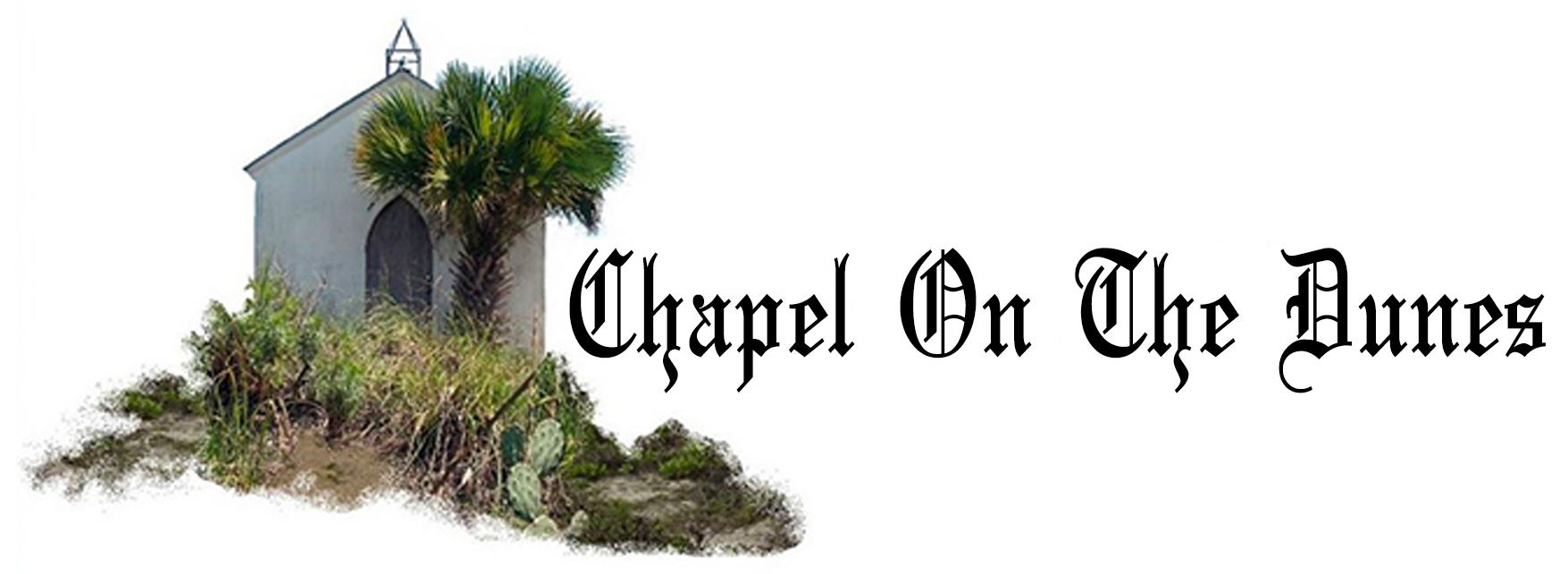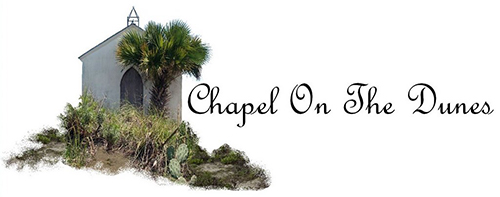Ethel Wilson Harris

Ethel Wilson Harris, March 1919. (Courtesy of Susan Toomey Frost)
Ethel Wilson Harris, a noted artisan of San Antonio and champion conservationist, was born in Sabinal, Texas in 1893. Harris became one of San Antonio’s most influential women in the realm of arts, culture and preservation. As an entrepreneur she founded what would collectively be known as the San Jose Tile Workshops, which included Mexican Arts and Crafts (1931-1941), San Jose Potteries (1934-1945) and Mission Crafts (1941-1977).
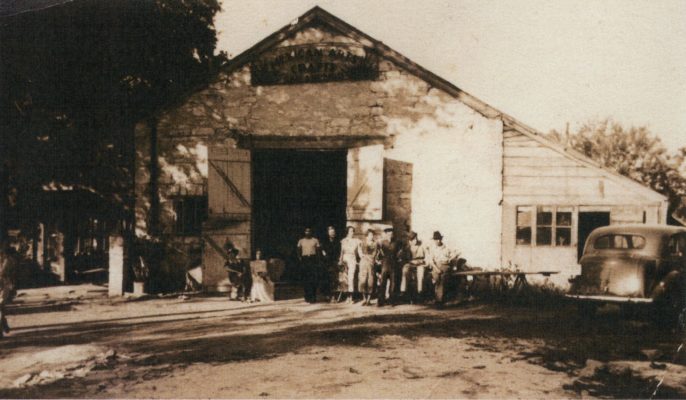
Mexican Arts and Crafts workshop at Nat Lewis barn at 1002 N. St. Mary’s St. (Courtesy of Susan Toomey Frost)
Harris became the technical supervisor of the Arts and Crafts Division of the Works Projects Administration (WPA) in San Antonio in 1939. As a conservationist, Harris was a charter member and president of the San Antonio Conservation Society as well as the co-founder of Night in Old San Antonio (NIOSA). Her home, on the grounds next to Mission San Jose, still stands and serves as a reminder of her efforts to preserve the San Antonio missions as Manager of San Jose Mission State Park.
Ethel Wilson Harris left a rich legacy of conservation and artisanship. Her support of Fernando Ramos, an artist she identified and nurtured in tile work, is popularly seen in the San Jose Tile designs. Many murals and tile works may be found throughout San Antonio, both in private residences and commercial settings. Another relevant contribution is that of her tile work for the Saint Dennis Mission Church located on Ranch River Road near U.S. Highway 77 in Refugio County in the private O’Connor Ranch. In honor of her life and work, Susan Toomey Frost donated a 120 tile WPA era mural (formerly installed in a Maverick family home on Huebner Road) to the San Antonio River Foundation. The mural was placed near the site of the old Nat Lewis barn. Wilson’s “first workshop—Mexican Arts and Crafts—was housed in in an [sic] historic barn [the Nat Lewis Barn] on the river at 1002 North St. Mary’s, where El Tropicano Hotel now stands.” The close proximity to the Maverick Carter House (across the river to the north) explains the early ties to Aline Carter.
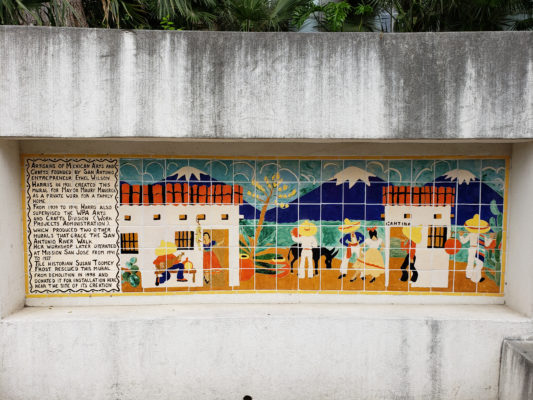
Tiles donated by Susan Toomey Frost at the site of the old Nat Lewis barn.
Chapel on the Dunes Construction
After the purchase of her Port Aransas house at 620 E. Avenue B in 1937, Aline B. Carter commissioned her friend Ethel Wilson Harris to construct a small chapel on the high dune to the south. A decade earlier in 1925, Harris had built an observatory on the roof of Aline’s home in downtown San Antonio. Additionally, Harris converted Aline’s home library into a small chapel with arched ceilings and furnished it with chairs built by her husband Arthur Harris. The chapel design in Port Aransas is that of an irregular convex hexagon design. It would also feature an arched ceiling and a window on each wall. Aline wanted the chapel to fit atop the sand dune in both a proportional and complementary fashion. There it was to be a sanctuary for islanders after the devastating 1919 Hurricane destroyed most religious buildings. In keeping with that spirit, the chapel design was simple and universal. As a source of inspiration and meditation for all, Aline desired white stucco walls.
Harris fulfilled these aims largely by herself over the course of many months of construction and transport. Aline’s son, Frank Carter, recalled the arduous process of collecting building materials. The Carter family gathered the flagstone from the Hill Country. Other materials were brought by Harris. Frank noted “[t]he woman [Ethel Wilson Harris] that put [the flagstone] in…she practically did it by herself. She could throw a fifty pound sack of cement over her shoulder and take off like a mule.”
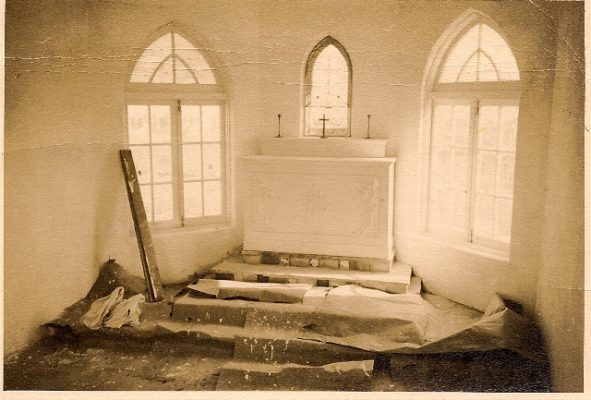
Chapel during construction c. 1938
The white stucco structure built with wood beams and stud framing stood on a concrete foundation. Per interview with Barbara Witte-Howell, great granddaughter of Ethel Wilson Harris, their family recalled the story of how difficult the construction became. Harris had to transport and haul sand to the Island due to the unsuitability of the local sand to mix with the cement and settle. All material came across the channel via ferry, or, quite often, by shrimp boat or passerby.
 According to Susan Toomey Frost, regarding the origin of the tiles on the risers, she notes “that San Jose tiles were used for accents and risers in the Harris House at Mission San Jose.”
According to Susan Toomey Frost, regarding the origin of the tiles on the risers, she notes “that San Jose tiles were used for accents and risers in the Harris House at Mission San Jose.”
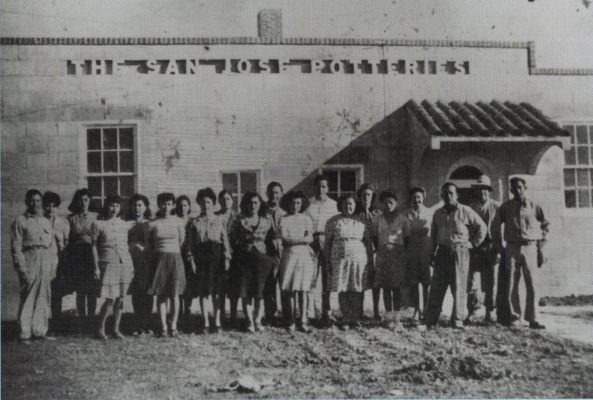
San Jose Potteries building (Courtesy of Susan Toomey Frost)
As for the ironwork above the altar and door, there are two possible sources. The likelier source appears to be that of Voss Metal Works. Ethel Wilson Harris frequently collaborated with metal artisans Theo Voss and Kurt Voss of Voss Metal Works for numerous projects. Ted Voss of Ted Voss Metal Works, Inc. indicated the ironwork had the appearance of his grandfather’s style of artisan craft. Additionally, Voss Metal Works provided several items for the Maverick Carter House in the mid-1920s, indicating a history of prior patronage to the family in that era. It must be noted, however, of the possibility the ironwork originated from Mexican Arts & Crafts, as Susan Toomey Frost notes it “also had its own metal artisans who could have made the ironwork” in that time period.
During restoration, Sienna Dunis Ginn of Dunis Studios reproduced several of the flower tiles. Sienna is a skilled artist and owner of a internationally recognized specialty tile business, with works on the San Antonio River Walk and noted venues across the world. One missing tile on the altar was replaced while the remaining tiles were used in fixtures and tables according to the style of Mexican Arts and Crafts. In replacing the tired door from 1999, the family found the old original door in storage and set about recreating it with one modification for support. Stan Gluza of DoorTex built the door and frame. A skilled woodworker, Stan has repaired or built many historic and grand doors, including the Panna Maria Immaculate Conception of the Blessed Virgin Mary Catholic Church and the St. Mary’s Catholic Church of Fredericksburg, Texas.
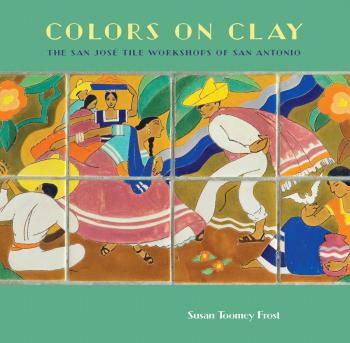
Historic photographs courtesy of Susan Toomey Frost. For more information on Ethel Wilson Harris and San Jose Tile Workshops, please refer to the authoritative work Colors On Clay.
For Map Link Locations of Tile Murals in San Antonio:
Former home of Ethel Wilson Harris (1955) (Mission San Jose Building)
Mural depicting a Mexican village (River Walk by El Tropicano Hotel)
W.P.A. Tile Mural depicting a “Century of Sports in San Antonio” (1941) (Alamo Stadium entrance)
W.P.A. Tile Mural depicting the “Old Mill Crossing” (1942) (Between Presa and Navarro Street Bridges)
W.P.A Tile Mural depicting the “Twin Cypress” (1942-44) (Stairway by the flood control gate)
Decorative fountain in the Menger Hotel courtyard (1950) (Menger Hotel)
For additional reading please see:
Frost, Susan Toomey. Colors on Clay: The San José Tile Workshops of San Antonio. Trinity University Press, 2009.
Casura, Lily. “A Force of Nature: Ethel Wilson Harris.” ExpressNews.com, San Antonio Express-News, 25 June 2017, www.expressnews.com/sa300/.
Casura, Lily. “Tile Murals on River Walk Are Hidden Treasures Worth Hunting.” ExpressNews.com, San Antonio Express-News, 10 June 2017, www.expressnews.com/.
“Colors on Clay: Gallery Guide.” Mexic-Arte Museum, Mexic-Arte Museum, 2011, www.mexic-artemuseum.org/.
San Antonio River Foundation. “W.P.A.-Era Mural to Return to River.” Tile Heritage, San Antonio River Foundation, www.tileheritage.org/San Antonio River Foundation.html.
Tilley, Frank. “A Journey to St. Dennis Mission Church (w/Video).” The Victoria Advocate, 11 Apr. 2014, www.victoriaadvocate.com/.
“Ethel Wilson Harris House.” Mission Trails, The City of San Antonio, www.sanantonio.gov/Mission-Trails/.
Hillburn, Elizabeth. “San Antonio River Walk Tile Plaques – San Antonio TX.” The Living New Deal, 1 Mar. 2014, livingnewdeal.org/projects/san-antonio-river-walk-tile-plaques-san-antonio-tx/.
Qwkdog Design, “San Jose Mission Pottery.” The Maximalist Colorware History & Design, www.maximalist.org/colorware/san-jose-pottery/
Qwkdog Design, “San Jose Pottery Flower Tiles.” The Maximalist Colorware History & Design, www.maximalist.org/2021/05/san-jose-pottery-flower-tiles/
